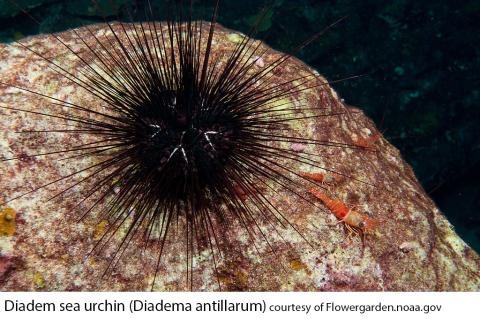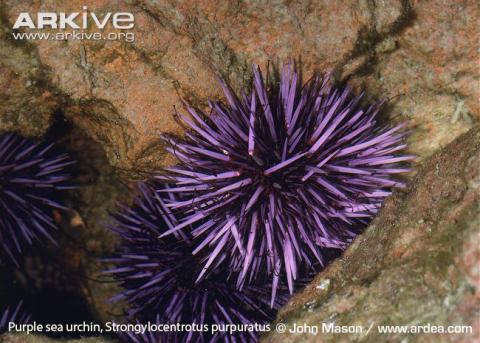
The round appearance of urchins comes from the inner shell, called a "test.” The urchin is covered with pincers (pedicellariae), spines and tube feet. They use their spines for protection and to catch food. Like sea stars, they use their tube feet to move and also to pass seaweed, their main food, to their mouths. Surrounding their mouths are five plates, called “Aristotle’s lantern”. These “teeth” pull food into the mouth and can even dig into rock to make the animal a home.
Climate change may affect sea urchins in a couple of ways. In the tropics, scientists have found that the adults of some species can handle a slight rise in ocean temperature, but their larval forms show abnormal development or die.
Since the sea urchin’s test is made of calcium carbonate plates, increasing ocean acidification may affect it. Scientists have seen some sea urchins with short, thin spines and others with thin tests.
However, scientists at Stanford and their colleagues had different results. They raised adult purple sea urchins (the species off the Central California coast) in seawater with either high or low carbon dioxide levels. When the urchins spawned, the scientists looked at both early and late stage larvae. They were surprised that most of the larvae in high carbon dioxide waters were healthy. And, because the genome of these urchins is known –it’s the most studied of any marine animal—the scientists used DNA-sequencing and analysis to determine which elements of the larvae’s genome changed in these different conditions. The genetic analysis showed that the healthy larvae had activated some genes that allowed them to adapt to the new conditions. The scientists assume this adaptability is because this urchin species lives with seasonal upwelling of cold, high carbon dioxide seawater. Other marine organisms with a lot of genetic variability may have genes in their toolkit that will let them adapt to the changing oceans of the future.
This Virtual Ocean website has lesson plans, tutorials and other modules for teachers to use in their classroom.
Read about the Stanford experiment Urchins and an acid ocean.
Read about the research on tropical urchin larvae and warming ocean: Tropical urchins caught between a rock and a hot place.
















